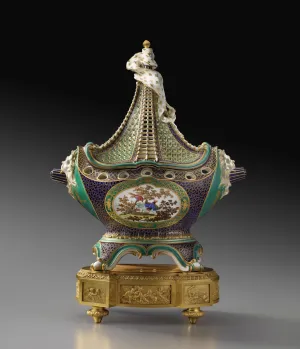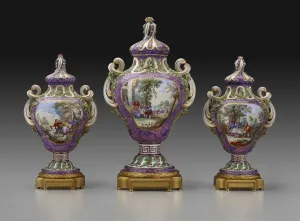Complete Checklist
Pot-pourri à Vaisseau
Sèvres Porcelain Manufactory
French, ca. 1759
Soft-paste porcelain
17 1/2 x 14 7/8 x 7 1/2 in. (44.5 x 37.8 x 19.1 cm)
Henry Clay Frick Bequest, 1916
The highly original design for this pot-pourri à vaisseau (potpourri in the form of a ship) was created in 1757, most likely by the Sèvres manufactory’s artistic director, Jean-Claude Duplessis. The piece can be dated to about 1759, the year that Sèvres began producing potpourri ships of this size (initially, they were smaller). The painters and gilders responsible for its decoration juxtaposed grounds of apple green and dark blue, the latter enriched with gold in a caillouté (pebble-like) pattern.
Pair of Vases à Oreilles
Sèvres Porcelain Manufactory
French, ca. 1759
Soft-paste porcelain
Each, h. 12 1/2 in. (31.8 cm), diam. 6 5/8 in. (16.8 cm)
Henry Clay Frick Bequest, 1916
Probably designed by the silversmith Jean-Claude Duplessis, vases of this type are called à oreilles (with ears) because the foliar scrolls at the neck loop back to the shoulder to form ear-like handles. One of the most successful vase forms produced by Sèvres’s celebrated porcelain manufactory, vases à oreilles were made in five sizes, ranging from about four and a half to fifteen inches.
Three Pots-pourris Feuilles de Mirte or à Feuillages
Sèvres Porcelain Manufactory
French, ca. 1762
Soft-paste porcelain
Larger vase: 14 3/16 x 8 1/2 x 7 1/8 in. (36 x 21.6 x 18.1 cm)
Smaller vases: 11 x 6 3/4 x 5 1/4 in. (27.9 x 17.1 x 13.3 cm)
Henry Clay Frick Bequest, 1918
Jean-Claude Duplessis adapted the shape of these vases from silverworks made some ten years earlier. Produced at the factory from 1761 to 1768, they were called either pots-pourris feuilles de mirte or à feuillages, a reference to the entwined myrtle leaves on the sides and neck of the vases, as well as to their eventual content (myrtle leaves were the essential ingredient in potpourri mixtures of dried flowers, herbs, and spices).
Vase Japon
Sèvres Porcelain Manufactory
French, 1774
Hard-paste porcelain with silver-gilt mount
H. 10 1/2 in. (26.7 cm), diam. 8 in. (20.3 cm)
Purchase in Honor of Anne L. Poulet, 2011
On view late May
Despite its name, the vase japon is an interpretation of a Chinese bronze Yu (or Hu) vase from the Han Dynasty (206 B.C.–220 A.D.). Its design and decoration derive from a woodblock print published in a forty-volume catalogue of the vast Chinese imperial collections compiled between 1749 and 1751 at the behest of the Qianlong emperor. Around 1767, a copy of this catalogue was sent to Henri Bertin, who at the time was France’s secretary of state and commissaire du roi at the Sèvres factory.
Water Jug and Basin
Sèvres Porcelain Manufactory
French, 1781
Soft-paste porcelain with gilt metal
Jug: 8 1/4 x 5 5/8 x 5 1/8 in. (21 x 14.3 x 13 cm)
Basin: 11 7/16 × 9 7/8 × 3 1/8 in. (29.1 × 25.1 × 7.9 cm)
Gift of Miss Helen Clay Frick, 1934
Jean-Louis Morin (act. 1754−87), who painted the marine scenes on this water jug and basin, was the son of an army surgeon and studied surgery himself before becoming a porcelain painter. He began his career at Vincennes, where he painted cupids and infants after François Boucher but, perhaps inspired by his family’s army connections, came to specialize in battle scenes and coastal views, then very fashionable.
Water Jug and Basin
Sèvres Porcelain Manufactory
French, 1776
Soft-paste porcelain with gilt metal
Jug: 7 9/16 x 5 1/4 x 4 7/8 in. (19.2 x 13.3 x 12.4 cm)
Basin: 2 13/16 x 10 5/8 x 8 3/8 in. (7.1 x 27 x 21.3 cm)
Gift of Miss Helen Clay Frick, 1934
Dressing and grooming (often done in the presence of friends and visitors) were important in the life of an eighteenth-century aristocrat, and the manufactory at Sèvres produced many accessories, often in sets, for these activities, including small boxes, jars, and brushes in different shapes and sizes. Large jugs and basins used to wash one’s hands with scent infused water were usually displayed on the dressing table during the morning ritual or in the garde-robe as precursors of the plumbed-in hand basin.
Tripod Table
French, Paris, ca. 1783
Gilt bronze, oak, and Sèvres soft-paste porcelain
H. 29 1/2 in. (74.9 cm), diam. 14 5/8 in. (37.1 cm)
Henry Clay Frick Bequest, 1918
Furniture incorporating Sèvres porcelain plaques was particularly fashionable in Paris in the second half of the eighteenth century. This table was probably designed and sold by the period’s leading marchand-mercier (dealer of luxury goods), the partners Simon-Philippe Poirier and Dominique Daguerre, who received exclusive rights from the Sèvres porcelain manufactory to commission porcelain plaques for furniture. Painted with colorful cut flowers, the table’s two circular plaques are among the finest produced at Sèvres in the early 1780s.
Tea Service (Déjeuner)
Sèvres Porcelain Manufactory
French, 1767
Soft-paste porcelain
Teapot: 5 1/2 x 7 3/16 x 4 1/8 in. (14 x 18.3 x 10.5 cm)
Sugar bowl: h. 4 3/4 in. (12.1 cm), diam. 3 7/8 in. (9.8 cm)
Cups: 2 3/8 x 3 11/16 x 2 7/8 in. (6 x 9.4 x 7.3 cm)
Saucers: h. 1 3/8 in. (3.5 cm), diam. 5 3/8 in. (13.7 cm)
Milk jug: 4 5/8 x 5 x 3 1/2 in. (11.7 x 12.7 x 8.9 cm)
Henry Clay Frick Bequest, 1918
This tea service consists of a teapot, a sugar bowl (both named after Pierre Calabre, one of the factory’s stockholders), a milk jug, four cups, and four saucers. All the pieces are similarly decorated with polychrome birds in white reserved panels surrounded by a bleu céleste ground spangled throughout with gold dots. The birds were painted by Antoine-Joseph Chappuis (act. 1756−87), who specialized in painting birds and flowers on functional pieces like tea, dessert, and dinner services. In 1767, the year he decorated this tea service, Chappuis was also involved in painting birds on the 108-piece dessert service made for the Russian nobleman Count Kyril Razumovski (now at Waddesdon Manor, in Buckinghamshire, England). Some of the creatures on both services were copied directly from The Natural History of Birds and Gleanings of the Natural History by the English naturalist and diplomat George Edwards. Introduced to Sèvres in 1765 by the Duke of Richmond, who gave the manufactory his personal copies, these volumes allowed for a more accurate depiction of birds. Edwards’s red-beaked toucan is recognizable on one cup while a pink pompadour cotinga and a wall-creeper of Surinam adorn the teapot. Tea services were purchased separately or as part of a larger dessert service. MORE »
Two Plates, Two Round and Two Square Fruit Dishes (Part of a Dessert Service)
Sèvres Porcelain Manufactory
French, 1782 and later decoration
Soft-paste porcelain
Two plates: diam. 9 3/8 in. (23.8 cm)
Two round fruit dishes: diam. 9 3/8 in. (23.8 cm)
Square dish at left: 1 5/8 × 8 3/8 × 8 1/4 in. (4.1 × 21.3 × 21 cm)
Square dish at right: 1 5/8 × 8 1/8 × 8 1/8 in. (4.1 × 20.6 × 20.6 cm)
Henry Clay Frick Bequest, 1918
These plates and dishes belonged to a much larger dessert service that has been dispersed (including two additional plates in The Frick Collection, not exhibited). Neither its original size (possibly as many as a hundred pieces) nor its original owner is known today. The plates and dishes were made and decorated in 1782. The turquoise blue ribbon and the white band with gold rosettes were added later, probably in the nineteenth century. The polychrome flowers vary from piece to piece, but all include roses, anemones, poppies, ranunculi, bellflowers, asters, delphiniums, convolvuli, carnations, and tulips in various combinations and colors. Several painters specializing in flowers were involved in the decoration of the service, including Edmé-François Bouilliat (act. 1758−1810), Marie-Claude-Sophie Xhrouet (act. 1772−88), and Jean-Baptiste Tandart (act. 1754−1800), each of whom signed one or two of the pieces shown here. Fruit dishes (compotiers) were used as part of a dessert service, especially intended for dried, fresh, or caramelized fruits. Dessert services often included a tea service similar to the one presented in this exhibition. MORE »
Pair of Vases Duplessis à Enfants
Vincennes Porcelain Manufactory
French, 1753
Soft-paste porcelain
At left: 8 3/8 x 5 3/4 x 5 3/4 in. (21.3 x 14.6 x 14.6 cm)
At right: 8 3/8 x 5 7/8 x 5 7/8 in. (21.3 x 14.9 x 14.9 cm)
Henry Clay Frick Bequest, 1918
The earliest pieces of French porcelain in the museum’s collection, this pair of vases was made in 1753, when the porcelain manufactory was located in the royal château of Vincennes, east of Paris. Named after Jean-Claude Duplessis, who invented their unusual shape around 1750, such vases were sometimes produced with chubby little children in relief, as seen here. Symbolic of the four seasons, these figures are almost certainly modeled after drawings by François Boucher.
Pair of Vases Duplessis
Vincennes Porcelain Manufactory
French, 1755
Soft-paste porcelain
At left: 7 5/8 × 4 × 3 1/2 in. (19.4 × 10.2 × 8.9 cm)
At right: 7 3/8 × 4 1/4 × 3 5/8 in. (18.7 × 10.8 × 9.2 cm)
Gift of Miss Helen Clay Frick, 1934
Jean-Claude Duplessis is credited with designing the shape of these vases, one of the oldest produced by the porcelain manufactory in Vincennes. A successful model, it was made in at least five different sizes, always with a white ground and colorful flowers in relief; most are decorated with sprays of flowers and flowering branches. The floral garlands on this pair were painted by Denis Levé (act.
Sugar Bowl (Sucrier Calabre)
Sèvres Porcelain Manufactory
French, 1756
Soft-paste porcelain
H. 3 15/16 in. (10 cm), diam. 3 5/8 in. (9.2 cm)
Gift of Miss Helen Clay Frick, 1934
This sugar bowl is named after Pierre Calabre, one of the earliest stockholders in the porcelain manufactory. It was made in 1756, the year the manufactory moved from Vincennes to Sèvres, after a design invented in the early 1750s. The decoration is by Vincent Taillandier (act. 1753–90), who specialized in the painting of flowers on a small scale, among them, the roses, convolvuli, narcissi, cornflowers, and tulips seen here.
Sugar Bowl
Sèvres Porcelain Manufactory
French, 1764
Soft-paste porcelain
H. 4 7/16 in. (11.3 cm), diam. 3 13/16 in. (9.7 cm)
Gift of Miss Marcelle Brunet, 1980













